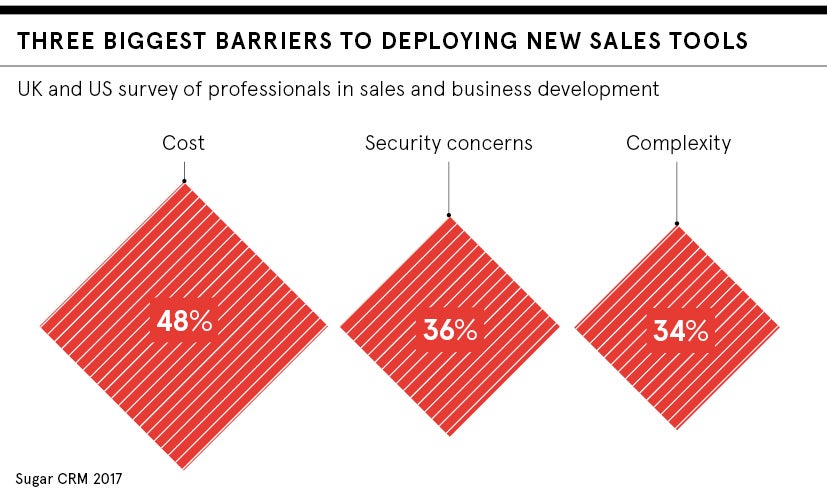Whether building a high-performing sales team or expanding an existing one, ensuring you have the right technology and talent in place is crucial. But when resources are limited and time is short, which takes priority and how can you ensure you get the balance right between the two?
In the view of Richard Hilton, managing director for Europe, the Middle East and Africa at sales training provider Miller Heiman Group: “Talent always comes first.”
Even in an increasingly sophisticated digital world, he believes the old adage that “people sell to people” still holds true and, while appropriate sales technology is important, its key role is that of “an enabler” rather than a deal-closer. In other words, the classic profile of an effective salesperson being someone who has good social skills, is naturally inquisitive, brave, creative and driven, is as valid now as it has ever been.
New skills will be need to use sales tech
As James Rix, co-founder and chief executive of marketing agency Crowdify, points out, when building a sales team: “You can’t teach someone how to sell if they’re not a natural sales or people person. You can teach someone to sell better and you can give them product and industry knowledge, but they still need a certain natural ability.”
Interestingly, Mr Hilton believes that over time as analytics tools start to play a progressively important role in supporting the sales process, this focus on emotional intelligence, or EQ, will be supplemented by a growing need for IQ in the shape of increased data literacy skills. Put another way, the technical expertise required to make the most of sales technology will steadily grow in value.
Should the decision be taken to expand an existing sales team, it makes sense to create a profile of an ideal candidate by devising a competency framework and combining it with a talent assessment. Competency frameworks lay out the core skills and characteristics required based on the type of sales approach used, while talent assessments explore what it is that makes an individual a high or low performer in your particular business.
Building a sales team
When building a sales team from scratch, however, the considerations are often quite different. In this instance, according to James Ewing, sales director at robotic process automation startup Digital Workforce, it is all about taking on “experienced people with a level of weight and gravitas as you only get one chance to make a good impression” with new customers.
Such sales talent must be well rounded and have experience of all aspects of the sales cycle, ranging from working on complex bids to account management. While many startups fall into the trap of taking on young, inexperienced sales staff in a bid to keep costs low, Mr Ewing advises that “building out the profile” in this way should only take place after the first three hires.
The same goes for purchasing sales enablement technology. “Good salespeople can operate using a notebook and email, so supporting technology is about scale out,” he says. “And you can’t scale out without technology because once you have more than three or four people, you need better reporting and, ideally, tools that support the sales cycle in a frictionless way.”
Key software in this context includes demand generation engines, online collaboration tools, email automation and sales intelligence applications, which sit on top of the more traditional customer relationship management (CRM) systems.
Yuri van der Sluis, founder of sales training company YuTrain, points out: “Technology isn’t just a hygiene factor. It helps your sales team to be more competitive. If you can use it to engage 50 per cent more qualified customers at a 10 per cent higher conversion rate and close them 25 per cent faster than your competitors, the difference it makes to your results is immense.”
Good technology complements good people
Mr Rix agrees. “If we turned off our technology today, the company would be about 60 to 70 per cent of the size, but the same would be true if we lost all our sales talent and ended up with people who don’t have any natural ability,” he says. “So the one feeds into the other: good people complement good technology and good technology complements good people.”
Nonetheless, how effective such software is generally depends on how it is employed by managers and can, in fact, be actively counter-productive. For example, in too many companies, CRM systems are simply used to capture and analyse financial data without any thought for how it could be deployed to enhance the sales process, or worse.
Mr Ewing explains: “Some systems are so cumbersome, they almost immobilise sales activity. In larger organisations especially, you have countless executives wanting to understand what’s happening and it just paralyses salespeople by bogging them down in minute detail they don’t see the value in.”
Therefore, to use technology effectively, it is important to employ it as a motivational tool rather than as a stick with which to beat your sales talent. Crowdify’s Mr Rix, for example, records each sales call and keeps an eye on the CRM system to understand key activities, such as where leads are coming from and what conversion rates are looking like.
“It gives me a bird’s eye view of performance and helps with training,” he says. “For example, good salespeople are often not so good at time management, but if I can show them how it’s affecting their performance and, therefore, their commission cheque, they tend to make decisions around changing their behaviour themselves.”
Ultimately though, the real secret to success is in hiring engaging, ambitious people and surrounding them with complementary technology to help them become more efficient, achieve client goals and benefit themselves as well as the company. “So tech and talent are both important, just in different ways,” Mr Rix concludes.
New skills will be need to use sales tech
Building a sales team
Good technology complements good people

